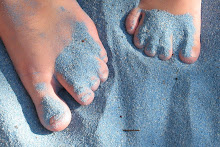While doing a little random reading this weekend, I stumbled across an article about Vampire Squids, which are neither vampires (my friend, Tim, will be disappointed), nor squids. It's a cephalopod. (Didn't Will Smith's character chase down a cephalopod in Men in Black? I don't think he'll be running this critter down in a sequel. It lives at least 300 feet below the ocean's surface.) When startled, it turns the webbed area with its eight legs inside out. If you don't believe me, check out this link www.bit.ly/vampiresquid.
I also read an article about why clock hands run "clockwise." The direction is a leftover from the early sundials. In the northern hemisphere, the shadow of the dial on a sundial traces "clockwise" as the sun moves through the sky. So, when clocks were first made during Medieval times, the hands were made to run in the same direction. (This begs the question -- wouldn't it still be "clockwise" if they all ran the other way?)
Some randoms on sundials:
1. Before wristwatches, people carried folding sundials with a small magnet to find north.
2. What is possibly the world's largest sundial is actually a bridge connecting the two parts of Turtle Bay Park, spanning the Sacramento River in the heart of Redding, California. You can get a look at it here => http://www.turtlebay.org/sundialbridge
3. The thin rod or sharp, straight edge a sundial uses to case a shadow is called a "gnomon." Gnomon is an ancient Greek word that means "indicator", "one who discerns," or "that which reveals."
And, finally, I didn't post last Friday because I was feeling "under-the-weather." Now, I'm back to feeling "over-the-weather."
Have a great day.
Monday, May 3, 2010
Subscribe to:
Post Comments (Atom)

No comments:
Post a Comment